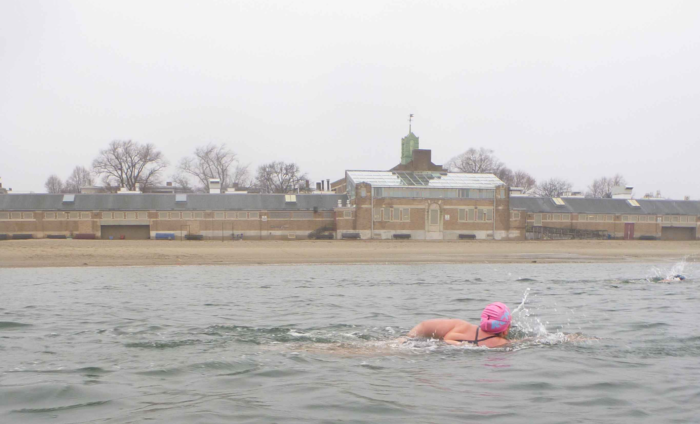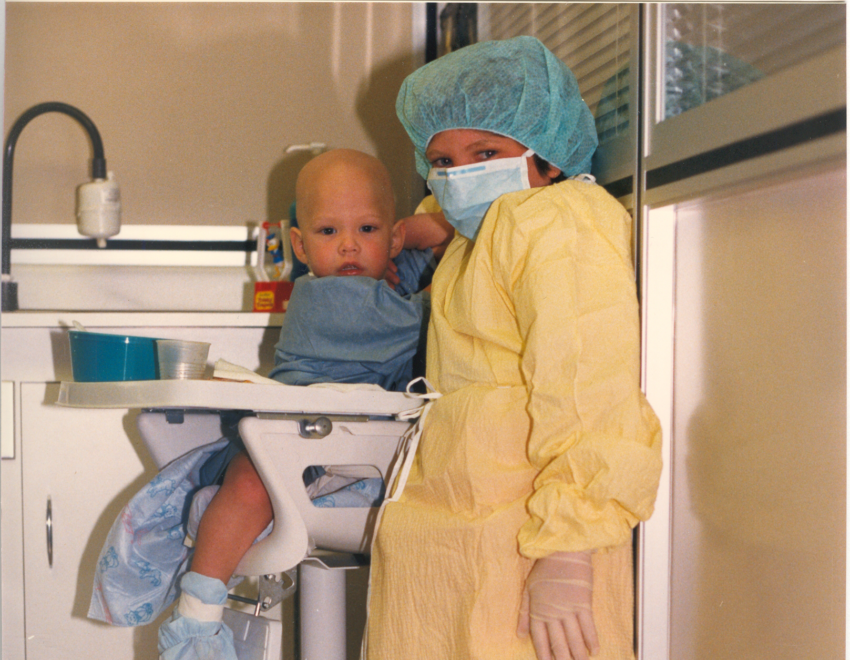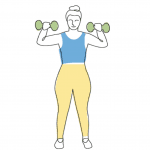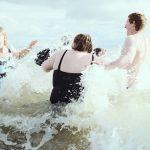
Why I’m not swimming right now: the temptation is real, but the risk is as well
“Hi. My name is Elaine, and it’s been 66 days since my last swim.”
That last swim was a 25 meter butterfly in water that was 30 degrees F at the Memphremagog Winter Swimming Festival in Newport, Vermont on February 29. It was a glorious, gasp-inducing 18 seconds of blind flailing though slush and fine ice crystals trying to knit themselves back together as a frozen surface. Had I known it would be my last swim for more than two months, I might have slowed down a bit to savor the searing sensation of sub-freezing water across my skin.
But the day after that festival, my family and I flew to Egypt for a 10-day vacation that involved no swimming. The evening we arrived home (anxious and half-expecting that we’d be hustled into quarantine somewhere along the way), the first European travel restrictions were announced. Within the next day or two, I also got notification that the two pools I frequent would both be closed until further notice.
Though I could head out for open water—I certainly have the experience and the cold tolerance to have continued on with training as usual, weather and pandemic be damned—I have chosen to observe the stay-at-home advisory here in Massachusetts. I’m not swimming right now. And here’s why.
One
First, this isn’t the first time I’ve been in quarantine, and I understand to my core why such measures are important. When I was about 7 or 8 years old, I was exposed to chickenpox, just like most other children my age. However, I was not like most other kids who’d be packed off to chickenpox parties to get it over with.
Instead, that brief exposure at school led to two weeks in strict quarantine hell at my grandparents’ house on a neglected wooded lot in Wenonah, New Jersey. It felt like the longest two weeks of my life because I could not go home and I had an uncomfortable relationship with my grandparents. The two or three times I did venture back to my family home for brief visits, I was not allowed inside. I had to stand on the front stoop wearing a mask, and peer through the glass storm door at what my family was doing inside. Without me.
See, my little sister had leukemia, and exposure to even the most mundane of pathogens could kill her. So it was critically important that I keep my germs—and hence myself—well away from my very vulnerable little sister.
Seeing images on the evening news of health care workers having to have that same visit with their families—masked and with a glass divider between them—has been a poignant reminder of some of the hard moments that made me who I am. It’s also convinced me that my job right now is the same as it was that summer I was exposed to chickenpox—don’t kill the vulnerable. It’s a concept even this kid could grasp, so I’m struggling to understand why it’s so difficult for some adults to practice social distancing. It’s not even just about altruism—it’s about your own self-preservation.

Elaine and her sister Rachel at the hospital shortly before the bone marrow transplant.
Two
The second reason I’m not swimming right now is because a couple summers ago, while I was on a routine training swim from my beloved L Street bathhouse in South Boston, someone called the police.
It takes me about an hour and a half to swim to the JFK Library and back along the horseshoe-shaped Old Dorchester Bay, a shallow, protected basin where many of us train. I was well away from shore and the group I went out with that day when a civic-minded person made the unfortunate assumption that I was in trouble. I had gotten a bit ahead of my friends—my training plan called for more distance that day than the others needed, and so I had started a bit sooner than everyone else. I think my tow float made me more visible from shore.
I had no knowledge that anyone was concerned about me as I was chugging along, thinking of the big swim I had planned in about six weeks’ time. I did notice, however an ambulance near the JFK Library on my left and wondered briefly what had happened.
About a quarter of a mile ahead, I noticed another ambulance and a few police vehicles near the volleyball pit at Carson’s Beach. A few strokes later, I breathed to my right and noticed a fire engine and a few more emergency response vehicles parked at the beach wall where G Street terminates into Day Boulevard about a half mile across the curve of the bay. There were also a cluster of emergency response vehicles and personnel on the beach next to the bathhouse I was headed back toward.
Given this robust response, it was clear something serious had happened. But I had no inkling I was the source of the issue until a boat sidled up to me.
As an open water swimmer—especially one who’s out on her own and knows she shouldn’t be—my first instinct was to get as far away from the boat as I could as quickly as possible. But the boat puttered up and idled again. I could see a policeman waving to me. So I sat up in the water and said hello. He informed me that I needed to get in the boat because someone had called in a rescue of a swimmer in distress.
Despite my clear lack of distress—we were having a conversation while I treaded water, clearly I didn’t need rescuing, I pointed out—the rules were I had to exit the water. The officer pointed out the two other boats—a coast guard auxiliary and the environmental police—that had arrived to assist, and he explained that none of them could leave until the swimmer had been returned to dry land. So we struck a bargain—they escorted me to the closest piece of sand, and I got out, ostensibly to walk back along the beach. (Given the air temperature and presence of glass on the beach, that walk could have actually been more dangerous than simply letting me swim back to my starting point, but that’s not the issue here.)
No, the issue is that because a vigilant member of the public rightfully made a phone call to emergency services when they thought they saw an emergency in progress, some two dozen EMTs, police, and other responders lost at least an hour to an emergency that wasn’t.
I was horribly embarrassed by this squandering of public resources and that I’d caused such a fuss for my silly hobby. How many people might have actually needed assistance while these individuals were searching for me?
In the context of this pandemic, which is severely straining our fragile health care system, I can’t in good conscience risk creating a similar situation. I wouldn’t just be embarrassed, I’d feel like a criminal. My hobby should never involve emergency response. Ever. If it does, I’ve done something wrong.
Three
The third reason I’m not swimming right now is because Massachusetts is a hot spot, and we’ve been told to stay home. Practically speaking, parking at several of my preferred open water entry points has been eliminated or restricted, and now that the weather is improving, some of these sites are experiencing rolling closures to restrict crowds.
But more importantly, maintaining a philosophical solidarity with those on the front lines matters to me—I think it’s important to honor the stay-at-home advisory and sit this one out.
To me, now is not the time to put myself or anyone else at potential risk of anything. As much as I adore swimming and use it as a mental health lifeline in times of stress, it’s just swimming. It will be there when things settle down, and I feel it’s my duty to ratchet my needs down a bit in deference to those who are dealing with much worse circumstances. We can’t do much as individuals to fight this pandemic. Staying home and staying out of the way is a small way to feel like I’m helping.
What’s more, I do believe that the more people try to circumvent stay-at-home orders and go swimming, the longer such orders are going to remain in place. It’s like an old swim coach I had who would only describe the workout verbally. He refused to ever write a set down on a white board or slip of paper stuck to a kickboard. It forced us to shut up and pay attention when the set was being explained.
And there were consequences to be had if we didn’t pay keen attention. If we did the set wrong, we’d just keep doing it over and over again until we finally got it right. I remember one day when he explained a particularly complicated set. We listened, but maybe not hard enough. We didn’t understand the set and we did it wrong. So, we had to do it over. We still didn’t do it right on the second try. So we did it over again. (Yes, he was a challenging and frustrating coach, but I did some of my best swimming while under his guidance.)
In the end, that day’s planned 4,000-yard workout ended up being closer to 10,000 yards. And there’s a parallel here in this crisis. Every day that we don’t pay attention to public health advisories and don’t do our part to sit this one out, that day is just going to get added onto the back end. If we don’t heed the important message that so many experts—virologists, epidemiologists, emergency physicians, etc., that I’ve been speaking with in my capacity as a health journalist over the past several weeks as this crisis has unfolded—have shared, we’re going to have to do this all over again. And again. And again. Better to get this right on the first try, so we can get back to normal as quickly as possible with as few casualties as possible.
So that’s why I’m not swimming right now. I admit, the nice spell of weather of the last couple of days has had me seriously reconsidering my commitment to staying dry-sided much longer. But for now, my gills are dry. It’s the one thing I can control in the whole big mess.









